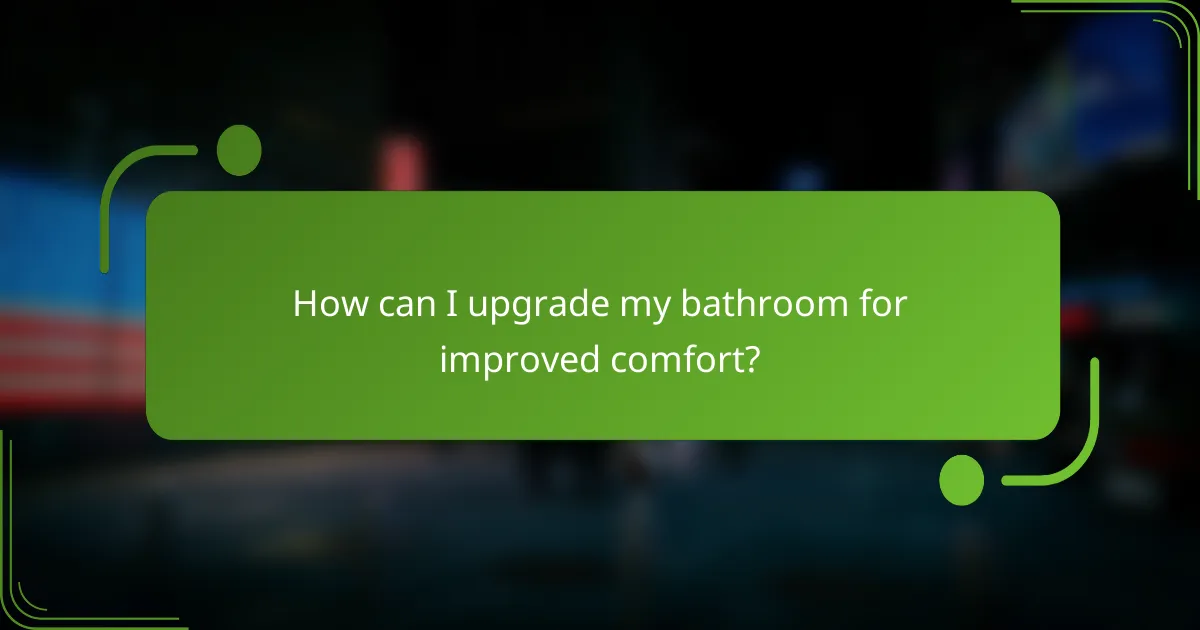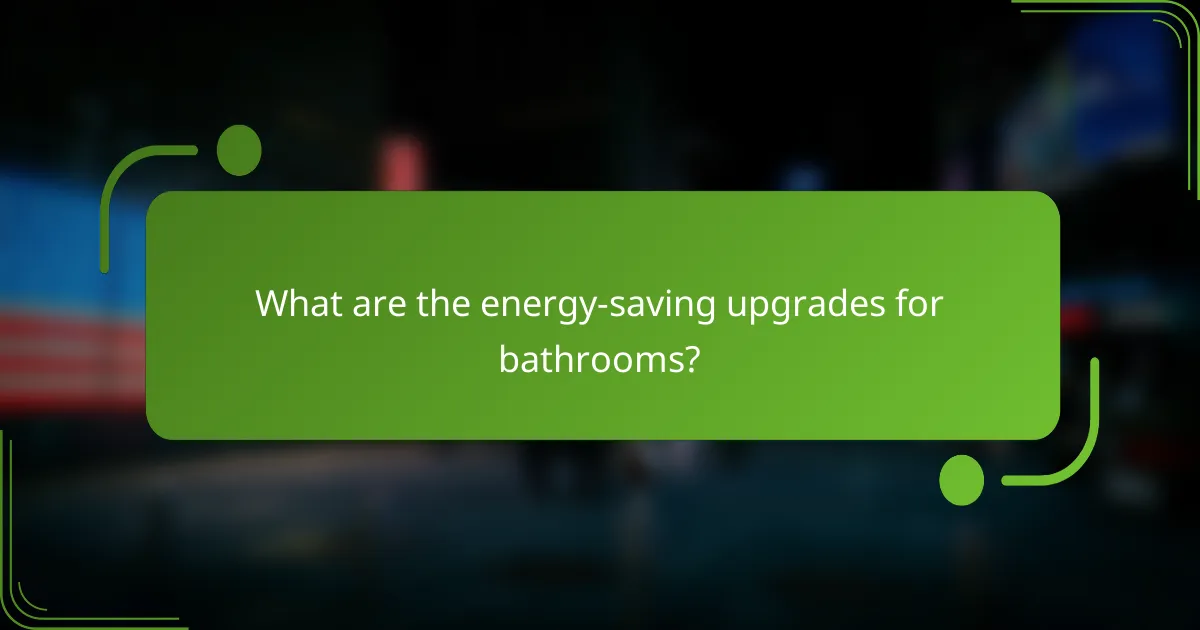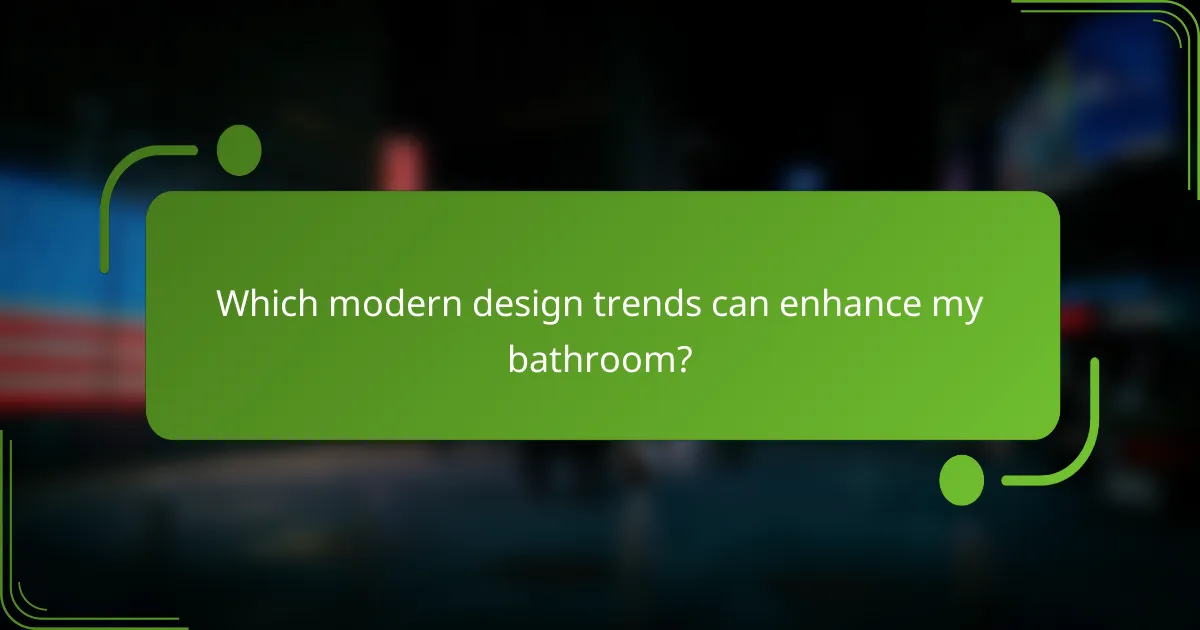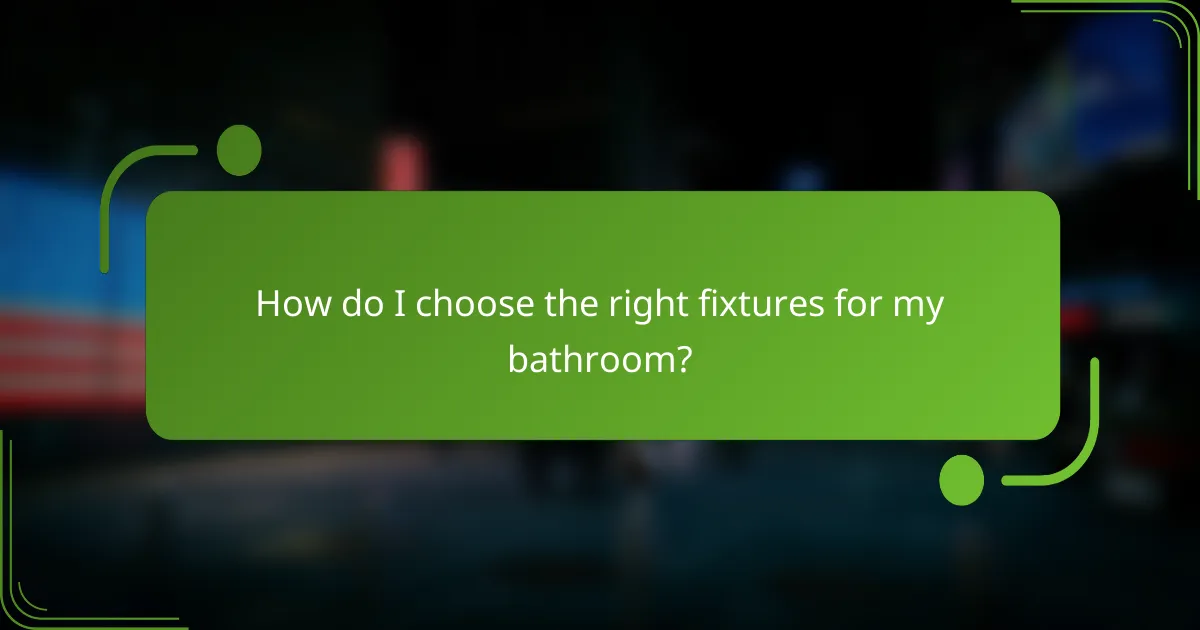Upgrading your bathroom can significantly enhance comfort, promote energy savings, and introduce a modern design aesthetic. By incorporating features such as LED lighting, low-flow fixtures, and stylish materials, you can create a relaxing and efficient space that reflects contemporary trends while reducing utility costs. Embrace the opportunity to transform your bathroom into a sanctuary of comfort and sustainability.

How can I upgrade my bathroom for improved comfort?
Upgrading your bathroom for improved comfort involves incorporating features that enhance relaxation and usability. Focus on elements that provide warmth, convenience, and a touch of luxury to create a more enjoyable space.
Heated flooring systems
Heated flooring systems provide a cozy underfoot experience, especially during colder months. These systems can be electric or hydronic, with electric mats being easier to install in smaller areas, while hydronic systems are more efficient for larger spaces.
When considering heated floors, ensure proper insulation to maximize energy efficiency. Installation costs can vary widely, so obtaining multiple quotes is advisable to find a solution that fits your budget.
High-efficiency showerheads
High-efficiency showerheads can significantly reduce water usage without sacrificing performance. Many models use less than 2.0 gallons per minute, compared to older fixtures that may use over 2.5 gallons.
Look for showerheads with the WaterSense label, which indicates they meet EPA standards for water efficiency. This upgrade not only conserves water but can also lower your utility bills over time.
Comfort-height toilets
Comfort-height toilets are designed to be taller than standard models, making them easier to use for individuals of all ages and abilities. These toilets typically measure around 17 to 19 inches from the floor to the seat, compared to the standard 15 inches.
When selecting a comfort-height toilet, consider the flushing technology to ensure it meets your needs for efficiency and performance. Many modern options also feature water-saving designs that can help reduce your water bill.
Soft-close toilet seats
Soft-close toilet seats prevent slamming, providing a quieter and more gentle closing action. This feature is particularly useful in households with children or in shared bathrooms where noise can be disruptive.
When purchasing a soft-close seat, ensure it fits your toilet model properly. Many brands offer universal designs, but checking compatibility can save you from installation headaches.
Luxury bath linens
Investing in luxury bath linens, such as plush towels and soft bath mats, enhances the overall comfort of your bathroom. Look for materials like Egyptian cotton or bamboo, which are known for their softness and absorbency.
To maintain the quality of your linens, wash them in cold water and avoid fabric softeners, which can reduce absorbency over time. Consider having a set for daily use and a more luxurious set for special occasions or guests.

What are the energy-saving upgrades for bathrooms?
Energy-saving upgrades for bathrooms focus on improving efficiency while enhancing comfort and modern design. Key upgrades include LED lighting, low-flow fixtures, smart thermostats, and energy-efficient water heaters, all of which contribute to lower utility bills and a more sustainable home.
LED lighting fixtures
LED lighting fixtures are a popular choice for energy-efficient bathroom upgrades. They consume significantly less energy than traditional incandescent bulbs, often using about 75% less electricity while lasting up to 25 times longer. This means fewer replacements and lower energy costs over time.
When selecting LED fixtures, consider the color temperature that best suits your bathroom’s ambiance. Options typically range from warm white to cool daylight, allowing you to create the desired atmosphere. Look for ENERGY STAR certified products to ensure optimal efficiency.
Low-flow faucets
Low-flow faucets are designed to reduce water consumption without sacrificing performance. These fixtures typically use 1.5 gallons per minute (GPM) or less, compared to standard faucets that can use 2.2 GPM or more. This reduction can lead to significant water savings, especially in households with multiple bathrooms.
To maximize savings, consider installing aerators, which mix air with water to maintain pressure while using less water. Additionally, check for local rebates or incentives for upgrading to water-efficient fixtures, which can further offset costs.
Smart thermostats
Smart thermostats can enhance bathroom comfort while optimizing energy use. These devices learn your schedule and adjust heating or cooling accordingly, ensuring that your bathroom is at the desired temperature when you need it. Many models allow remote control via smartphone apps, providing convenience and energy savings.
When choosing a smart thermostat, look for features like geofencing, which adjusts settings based on your location, and energy usage reports that help you track savings. Ensure compatibility with your existing heating system to avoid installation issues.
Energy-efficient water heaters
Energy-efficient water heaters, such as tankless or heat pump models, provide hot water on demand while using less energy than traditional storage heaters. Tankless water heaters can save space and energy by heating water only when needed, potentially reducing energy bills by 30% or more.
When selecting a new water heater, consider the size and flow rate that fits your household needs. Look for units with high energy factor (EF) ratings to ensure efficiency. Additionally, check for local regulations or incentives that may apply to energy-efficient appliances, which can help reduce upfront costs.

Which modern design trends can enhance my bathroom?
Modern design trends that enhance bathrooms focus on creating a comfortable, stylish, and energy-efficient space. Key trends include minimalist aesthetics, floating vanities, natural materials like stone, and bold tile patterns, each contributing to a contemporary feel while improving functionality.
Minimalist aesthetics
Minimalist aesthetics prioritize simplicity and functionality, often featuring clean lines and uncluttered spaces. This approach can make a bathroom feel larger and more serene, using a limited color palette and essential furnishings.
To achieve a minimalist look, consider using built-in storage solutions to reduce visual clutter. Opt for sleek fixtures and unobtrusive accessories that blend seamlessly into the overall design.
Floating vanities
Floating vanities are a popular choice in modern bathrooms, as they create an illusion of space and make cleaning easier. These vanities are mounted to the wall, allowing for more visible floor area and a contemporary aesthetic.
When selecting a floating vanity, ensure it complements your bathroom’s overall design. Consider materials that resist moisture and choose a size that fits comfortably within your space without overwhelming it.
Natural materials like stone
Incorporating natural materials like stone can add warmth and texture to a bathroom. Stone surfaces, such as granite or marble, not only enhance the visual appeal but also offer durability and longevity.
When using stone, consider its maintenance requirements and choose finishes that suit your lifestyle. For instance, honed finishes are less slippery, making them a safer option for wet areas.
Bold tile patterns
Bold tile patterns can serve as a striking focal point in a bathroom, adding personality and style. Whether through geometric designs or vibrant colors, these tiles can transform an otherwise simple space into a visually engaging environment.
To effectively use bold tiles, consider limiting their application to specific areas, such as the shower wall or backsplash, to avoid overwhelming the space. Pairing bold tiles with neutral colors can help balance the overall design.

What are the costs associated with a bathroom upgrade?
The costs of a bathroom upgrade can vary significantly based on the scope of work, materials chosen, and labor expenses. Homeowners should anticipate spending anywhere from a few thousand to tens of thousands of pounds, depending on the desired improvements and features.
Average renovation costs in the UK
In the UK, the average cost for a bathroom renovation typically ranges from £4,000 to £10,000. This price can fluctuate based on the size of the bathroom, the complexity of the design, and the quality of materials used.
For a basic remodel, expect to pay on the lower end of this spectrum, while a complete overhaul with high-end finishes can push costs toward the upper limit. Always consider obtaining multiple quotes from contractors to ensure competitive pricing.
Cost of high-efficiency fixtures
Investing in high-efficiency fixtures can lead to long-term savings on water and energy bills. Low-flow toilets, showerheads, and faucets typically cost between £100 and £500 each, depending on brand and features.
While the upfront cost may be higher than standard fixtures, the reduction in water usage can result in savings of up to 30% on water bills. Look for products that meet UK water efficiency standards to maximize benefits.
Budgeting for luxury features
Luxury features such as heated floors, custom vanities, and high-end bathtubs can significantly increase your bathroom upgrade budget. These additions can range from £1,000 to over £5,000, depending on the item and installation requirements.
When budgeting, prioritize which luxury features are most important to you and consider their impact on overall comfort and home value. It’s wise to allocate about 10-20% of your total renovation budget for these enhancements to avoid overspending.

How do I choose the right fixtures for my bathroom?
Choosing the right fixtures for your bathroom involves considering functionality, style, and energy efficiency. Focus on selecting items that enhance comfort while aligning with modern design trends and sustainability goals.
Consider Your Space
Evaluate the size and layout of your bathroom before selecting fixtures. Compact spaces may benefit from wall-mounted sinks and toilets, while larger areas can accommodate double vanities or freestanding tubs. Measure available space to ensure a proper fit and maintain accessibility.
Prioritize Water Efficiency
Opt for fixtures that promote water conservation, such as low-flow faucets and dual-flush toilets. These options can reduce water usage by 20-30%, translating to lower utility bills. Look for products with the WaterSense label, which indicates compliance with efficiency standards.
Match Your Style
Your fixtures should complement the overall design of your bathroom. Whether you prefer a modern, minimalist look or a more traditional aesthetic, select finishes and colors that harmonize with your existing decor. Mixing styles can be effective, but aim for a cohesive appearance.
Check for Quality and Durability
Invest in high-quality fixtures that withstand daily use. Look for materials like solid brass or stainless steel, which offer longevity and resistance to corrosion. Read reviews and consider warranties to gauge product reliability before making a purchase.
Stay Within Budget
Establish a budget for your bathroom fixtures to avoid overspending. Prices can vary widely based on brand and features, so compare options across different retailers. Consider shopping during sales or exploring second-hand options for significant savings.
